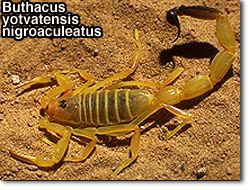Scorpions Scorpiones
 Almost everybody knows what a scorpion looks like even if they have never actually seen one. The image of their body-shape is ingrained in our minds from earliest times, and myth and superstition surround them. Many people fear and loath scorpions but in common with other venomous animals they normally avoid humans and will only sting when threatened. Most stings occur when people inadvertently come into contact with scorpions, particularly during camping trips, when they are found hiding under rocks, stones, tents, clothing, debris and rubbish. Almost everybody knows what a scorpion looks like even if they have never actually seen one. The image of their body-shape is ingrained in our minds from earliest times, and myth and superstition surround them. Many people fear and loath scorpions but in common with other venomous animals they normally avoid humans and will only sting when threatened. Most stings occur when people inadvertently come into contact with scorpions, particularly during camping trips, when they are found hiding under rocks, stones, tents, clothing, debris and rubbish.
Scorpions prey on other arthropods, particularly insects and arachnids but may also feed on small vertebrates. Scorpions that have very large pincers do not always use their sting to kill prey, but may simply rely on the crushing power of their claws.
They have a long gestation period and surprisingly are viviparous, meaning that they give birth to live young. Young scorpions are smaller versions of their parents. Maternal care of the young ranges from a few days to several months and can include complex behaviour such as co-operative feeding and burrow building. The lifespan of most scorpions is from two to five years but in at least one species it exceeds 25 years!
An interesting phenomenon concerning scorpions is the fact that they fluoresce when exposed to ultra violet (UV) light. No-one knows why this happens; it is just a natural property of the cuticle. However, it provides an easy way of detecting scorpions and is used by biologists to estimate their numbers without having to capture them. It is also an effective way of avoiding scorpions when camping, although in some desert locations it is alarming to see just how many the UV light reveals!
Scorpions in the UAE
Vachon (1989) lists 14 species or sub-species of scorpions from the Arabian peninsula. They belong to two families; the Buthidae and the Scorpionidae. There are eight genera of buthids: Androctonus , Apistobuthus ,Buthus , Compsobuthus ,Leirus , Orthochirus , Parabuthus and Vachoniolus , but only two genera of scorpionids: Hemiscorpius and Scorpio. To date only buthids have been found in the Emirates. They are Androctonus crassicauda , Apithobuthus pterygocercus , Buthacus yotvatensis nigroaculeatus , Compsobuthis arabicus , Parabuthus liosoma , Vachoniolus minipectibinus and possibly Vachoniolus globimanus , although it is not clear whether the latter are two separate species, or male and female of a single species. There may well be further scorpions awaiting discovery in the Hajar mountains.
A.crassicauda and A.pterygocercus are the two largest scorpions in UAE. Adults of both species can measure up to 150mm from their head to the tip of their sting and they can occur near human habitation. They are quite different in appearance. A.crassicauda is black with very chunky claws and a highly sculptured tail, while A.pterygocercus is pale-yellow with very long, slender pincers and a swollen disc-shaped second segment on the tail.
The most common species in sandy areas is B.y.nigroaculeatus which is mostly yellow, but is black on the last segment of tail and sting. Adults can reach up to about 75mm in length. The Vachoniolus spp. are slightly smaller and also yellow with a darker-coloured tip to their sting. The first Vachoniolus spp ever collected were from Bada Haza, Abu Dhabi. Both C.arabicus and P.liosoma are smaller and only reach about 25mm in length. The former is all yellow, while the latter is mainly pink, except for the last two segments of the tail and sting which are brown. I have also found a fragment from the tail of another scorpion, possibly Orthochirus innesi , which is awaiting confirmation.
Scorpion venom and stings
In recent years there has been much interest in the biology of scorpions, particularly their venom which is a mixture of some of the most potent and biologically active compounds in the animal kingdom. The venom of all buthid species contains powerful and dangerous neurotoxins. Of the buthids, Androctonus australis is considered to be very venomous and symptoms of its sting resemble strychnine poisoning. Its close relative, A.crassicauda. occurs in the Emirates and should be treated with caution. Victims of stings feel a sharp pain followed by numbness, drowsiness and an itching of the throat. This can be accompanied by excessive saliva and the tongue becomes sluggish with the jaw muscles contracted. If large amounts of venom have entered the blood system, difficulties in co-ordination arise and body temperature increases while the production of saliva and urine are reduced. Touch and sight can be affected, with sensitivity to strong light. There may also be haemorrhages and convulsions with increasing severity. Most victims are normally out of danger within three hours but they should receive medical supervision for at least eight hours.
Primary first aid for scorpion stings is to reassure the victim who will be suffering from shock. Clean the wound and then try to isolate it by immobilising the sight of the sting. Use a firm supporting bandage but not a tourniquet, and hold the limb up to avoid the venom going directly to the heart. If possible keep the site of the sting cold by placing it in iced water. Although fatalities are very rare, do seek medical help, particularly in the case of small children and invalids who are most at risk. In some cases, an anti-venom can be administered and these work well if given early enough. However, in other cases a pain killer is all that can be given but recovery should be rapid.
|